
Sometimes small critters come into an aquarium on plants or fish and become established. The most common denizens aquarium owners find are hydra, detritus worms, planaria and leeches. These are pictures of four of these pests:
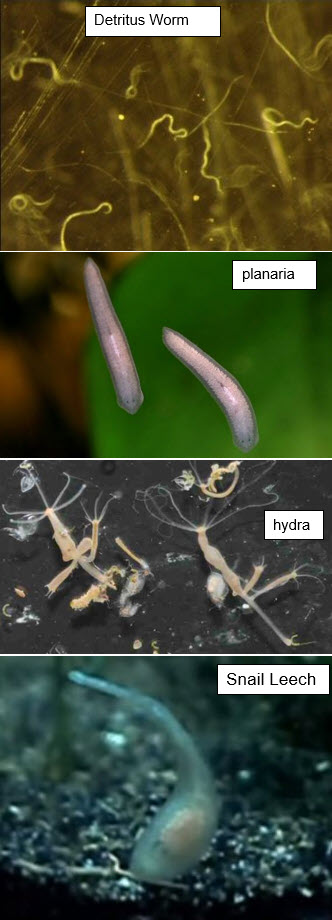
.
People often talk about “worms” in an aquarium and recommend “dewormers” to deal with them. This is somewhat problematic. There are three distinct groups of “worms” and a hydra group. These groups respond to different medications. They are:
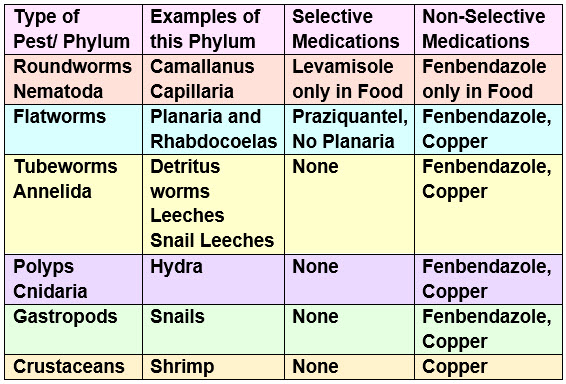
Note that the cautions about deaths of snails, shrimp and invertebrates is very dose dependent. Copper and Fenbendazole are often used with no snail deaths because the dosage isn’t high enough. Conversely using a very high dosage of fenbendazole can possibly kill shrimp. And Levamisole is safe for everything except nematodes. Praziquantel is safe with everything except planaria and flukes. But copper WILL kill shrimp at any reasonable dosage.
Identifying Pests
If one has small white or translucent “worms” or “wormlike critters” on the glass or in the water of an aquarium, the movement of the bodies of the “worms” indicates what they are.
- If the whole body of each of the “worms” is wiggling in spasmodic motion or scooting rapidly along on the glass or through the substrate much like a snake moves it is probably a “detritus worm”, most of whom are tube worms (annelida). “Detritus worms” typically are long and thin, curve around a lot and have no distinctive “head”.
- If the entire body of the “worm” remains attached and on the glass, moving in a slow gliding motion across the glass like a snail, they are a flatworm, either planaria which have an arrow shaped head or a rhabdocoelas which have a rounded head. Flatworms are very flat, short and relatively wide and their bodies don’t curve around a lot or change in shape.
- If half the body of the “worm” is waving in the water and half remains attached to the glass or in the substrate it is a species of leech. Leeches are round shaped, much like earthworms. Leeches often move by “looping”, attaching alternate ends of their bodies to the glass, head attaches, tail moves up, tail attaches, head moves forward, etc. This often results in the leech contracting to be a fat “grub” shape and then expanding to become a narrow long “worm” shape. Leeches also swim free in the water in sinuous “S” movements.
- If the body is attached to the glass a one end and the other end has several tentacles waving in the water, it is a hydra.
- If it is small white or black dots which move in rapid short bursts these are crustaceans.
Detritus worms, flatworms, leeches and hydra are discussed in separate articles (links are below). The other miscellaneous organisms found occasionally in an aquarium are discussed below.
Crustaceans
If the “pest” is a small white or black speck and is moving in rapid short bursts, it is typically a type of crustacean, an arthropod with a outer exoskeleton like an insect. These various crustaceans include such things as copepods (cyclops), ostracods (seed shrimp), and cladocera (daphnia). Fish love to eat these small pests so they rarely show up in an aquarium with fish in it. They are all completely harmless. These crustaceans can show up in huge numbers in aquariums with no fish.
Occasionally larger crustacean denizens such as amphipods (Gammarus or “scuds”) and isopods show up. They are also harmless.

Insects
Many insects can be found in the aquarium, typically brought in on plants. Sometimes the insects are in the house and just use the aquarium as a convenient breeding ground. A midge larva called a bloodworm (bright red) can be rarely found. And mosquito larvae show up occasionally. Plants can bring in many pond denizens to the aquarium. They are largely all harmless. Fish almost eat all of them. Very rarely a damselfly larvae will show up. These can eat fish fry.
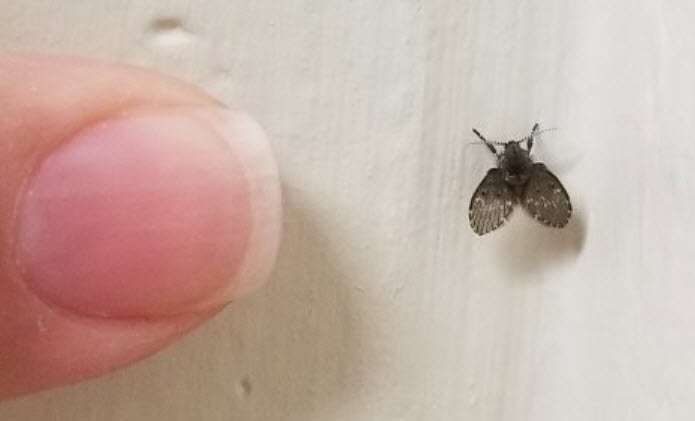
There is a type of worm that is the larvae of a type of fly called a drain fly (Psychodidae or moth fly) which lives in detritus in the aquarium. The larvae feed on bacteria and detritus. The adult flies look like small gray moths. The larvae have no legs but they do have small appendages coming off of each segment of their body. They look and move like tiny caterpillars.
The segments on a drain fly larvae are much more pronounced than on a leech. This can form very persistent infestations with little grey flies found all over the home. They are harmless to fish and are a very good food for fish.
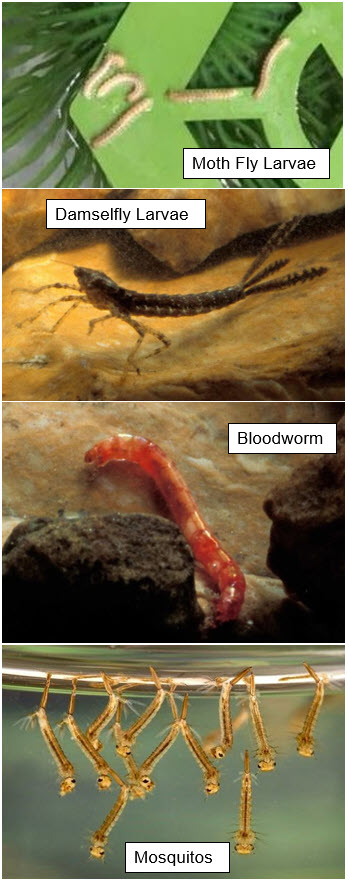
Bloodworms
Often times people find reddish or reddish brown worms in their tank and panic because they think they have camallanus or capillaria, nematode worms which are killers of some fish. If the worms are moving they are not camallanus or capillaria.
Pathogenic worms such as capillaria and camallanus are only found in the fish unless they have been paralyzed with a medication. If they have been paralyzed they will be found motionless on the substrate. Camallanus or capillaria worms are nematodes; their bodies are relatively slender and featureless, and the only free-living life stage is microscopically small. They do not move about the aquarium or swim through the water. So one should not suspect pathogens if one sees long thin worms moving in the aquarium (unless one has shrimp).
Most “bloodworms” are the larvae of a chironomid midge fly. A midge is a type of fly that looks somewhat similar to a mosquito. Midge bloodworms have a distinct head capsule, mandibulate jaws, clear segmentation along the body, and often a single proleg (like the ones along the underside of a caterpillar) sort of just under the throat. Midge bloodworms also sometimes have a few small tentacle-like growths near the end of the abdomen.
Bloodworms are a very common and very good food to feed all fish. Note that there is a myth that bloodworms cause bloat. Ignore the well-intentioned commentators on social media that parrot that old myth.

Note that some rare detritus annelid worms have hemoglobin in their blood and are bright red. These are sometimes called “bloodworms”. They do not have heads or any legs and look just like small red earthworms.
Hair Worms
Note that in a shrimp tank some very long thin white worms show up occasionally which are the adult form of parasitic “hair worms” or “horse hair worms”. These are a type of nematode which live coiled up inside the shrimp. In ghost shrimp you can see the worm inside the shrimp. These parasites can be treated with Levamisole or Fenbendazole in the shrimp food.
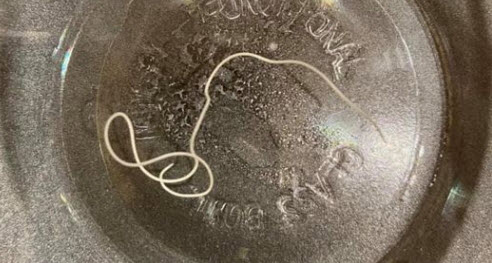
“Limpets”
All snails with flat shells like half a clams shell (a patelliform shell) tend to be called “limpets”, even when they’re only distantly related. There is a type of marine snail which has a flat shell. It is correctly called a limpet. There are then what hobbyists call freshwater “limpets”, which aren’t actually true limpets, but are ramshorn snails (family Planorbidae genus Ferris) with flat shells.
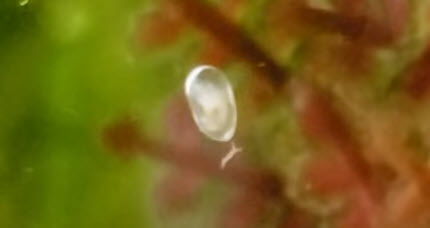
These freshwater “limpets” often show up on the glass of aquariums in large numbers and cause concern. They are harmless, as are all snails. They can be controlled with copper. Copper kills all invertebrates in an aquarium.
For information on the four most common aquarium pests (detritus worms, leeches, flatworms and hydra) go to the articles below.
Hydra
If the “worm” is waving in the water and has a head with several arms, it is a hydra. Hydra aren’t a worm, they are a quite different critter more closely related to anemones. Here is a link to more on hydra:
10.13.1. Hydra
Detritus Worms
Most detritus worms are simply earthworms which live in the detritus in the substrate in an aquarium. They move just like earthworms. Detritus worms are found in virtually all aquariums and proliferate if the substrate is too large or one over feeds the fish. More information on them can be found at this link:
10.13.2. Detritus Worms
Planaria
Planaria and rhabdocoelas are common as small very flat worms gliding (much like snails) on the glass of the tank. They are rarely present in large numbers. For more on them go to this link:
10.13.3. Planaria
Leeches
And another common denizen is the leech. One type of aquarium leech is the snail leech. The snail leech is a rather gross worm-like critter which has a fat body which attaches to the glass or the substrate and a thinner head which then waves back and fourth in the water. Then there is the red brown Asian leech which feeds on invertebrates, including shrimp. Information on these leeches can be found at this link:
10.13.4. Aquarium Leeches
Bryozoans and Stentors
Two creatures that look somewhat like hydra but are not, are bryozoans and stentors. These are rare in the aquarium but always puzzling when they show up.
10.13.5. Bryozoans and Stentors
.
Return to Diseases Menu
.
Aquarium Science Website
The chapters shown below or on the right side in maroon lead to close to 400 articles on all aspects of keeping a freshwater aquarium. These articles have NO links to profit making sites and are thus unbiased in their recommendations, unlike all the for-profit sites you will find with Google. Bookmark and browse!
.

Dave says
Isopods as a part and parcel of a naturally occurring food web (Father Fish) are just fine. I wouldn’t go to all the trouble of raising them specifically as live food.
Dan says
saw a youtube video advocating for isopods as part of the aquarium food web. thoughts on this?
Dave says
In reply to Suzanne …. Darned if I know. Sorry.
Suzanne says
Do newly-hatched ramshorn snails have a “limpet” form? I had noticed in the last “clutch” that when they became large enough to see without magnification, they seemed to have an oddly flattened side. Googling has brought me no answers (what a surprise!)
(An online Aquatic Snails of Ohio Field Guide describes one Ramshorn type snail reversing the axis of its shell growth but I have a hard time picturing that)
Thanks for the excellent resource! :^)
Dave says
In reply to Jack …. You need to treat with copper at the same strength recommended for ich. That can be found at this article: https://aquariumscience.org/index.php/10-2-2-4-ich-medications-in-more-depth/ Note this is a hit or miss proposition. I’ve never been able to get rid of snails with ANY chemicals. I find loaches to be the best snail killers.
Jack says
Hi Dave, I have an infestation of Ramshorn snails in my Betta tank. At first, I was quite happy to leave them to it, but things are getting out of hand now they are breeding (and the Betta is not interested in eating them unless you smush them against the glass). I treated with fenbendazole wich had very little impact (now understand this may be due to the dose amount used) how do you recommend treating with copper?